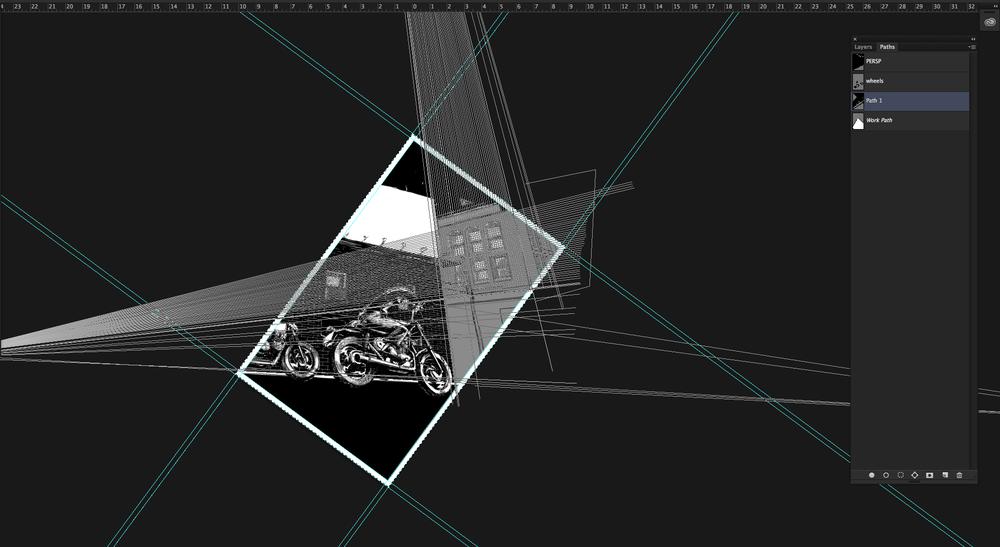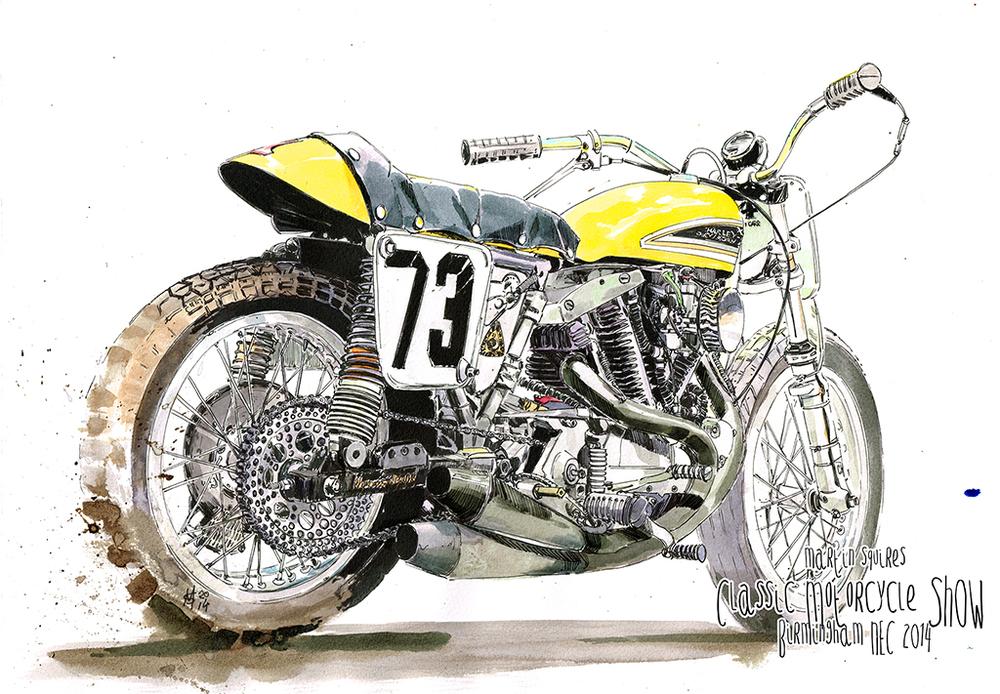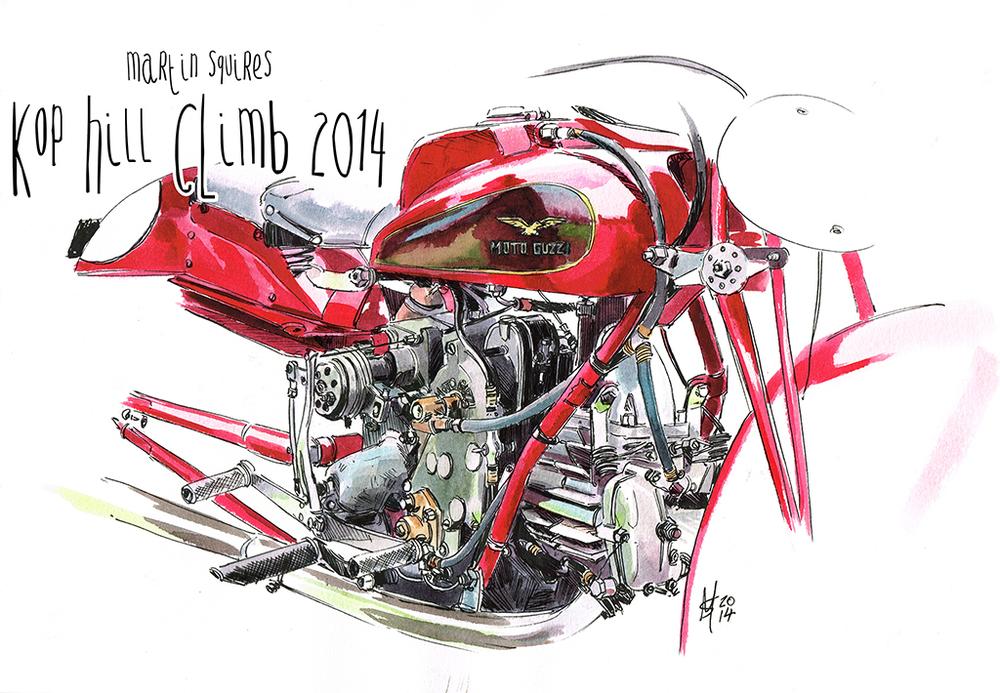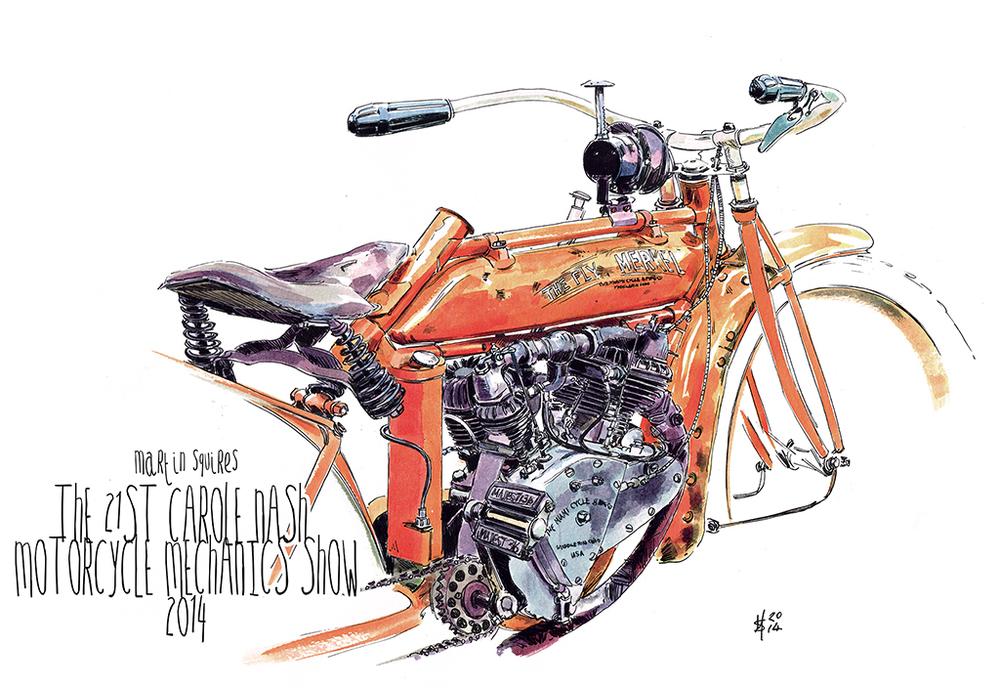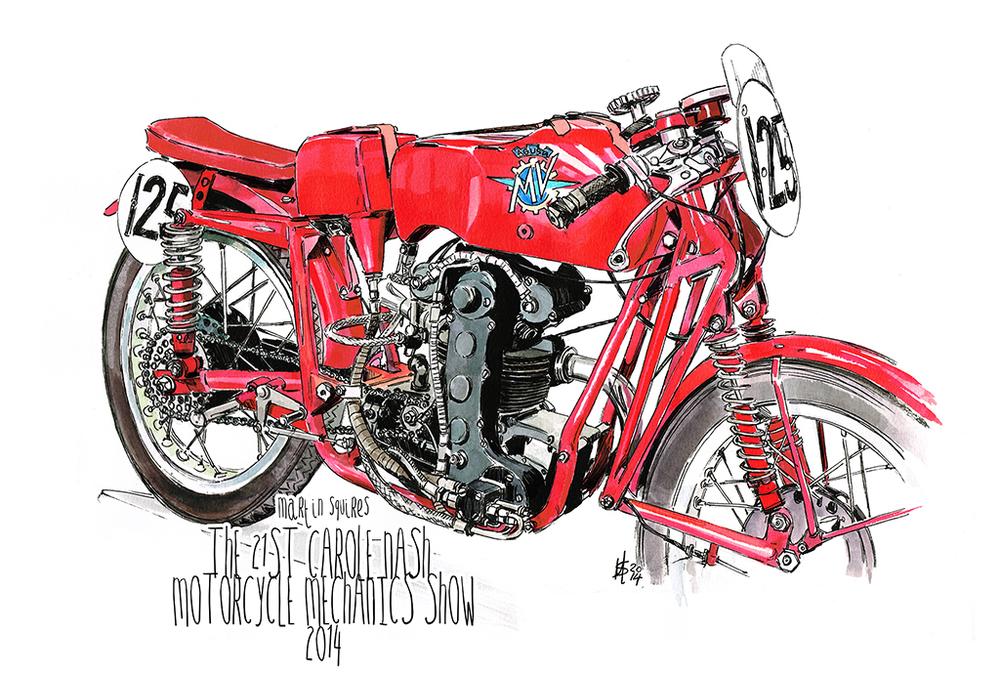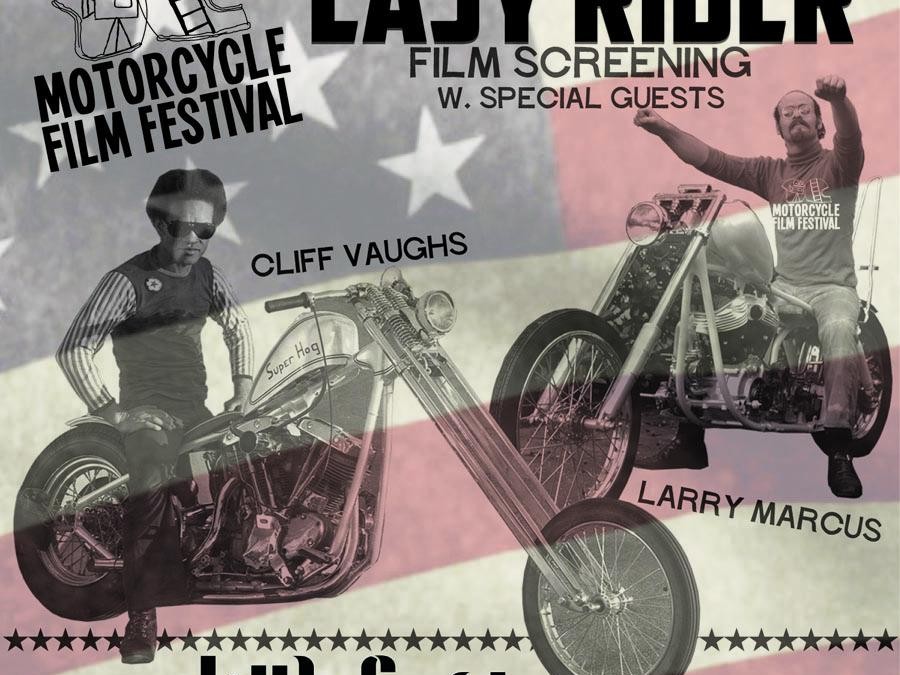 September 3, 2015
September 3, 2015
by Motorcycle Film Festival | Sep 3, 2015 | Uncategorized |
We are stoked to announce a special screening of “Easy Rider” (1969) on Wednesday 9/23 at 8pm. Special guests include: Associate Producer Cliff Vaughs and Sound Engineer Larry Marcus – the ‘lost’ film crew who built the Easy Rider choppers. Hosted by Paul d’Orleans, The Vintagent, in conjunction with Cine Meccanica. The classic film will put the 3rd Annual MFF on the road!

*Doors open at 6pm, with a free opening reception from 6-8pm
April 27, 2015
by Motorcycle Film Festival | Apr 27, 2015 | MFF 2015 |
We’re pleased as a podium finish with the artwork for this year’s MFF. For our third annual, artist Rich Lee brings us something completely different. We caught up with Rich to learn more about his art, influences, interest in motorcycles, and children’s books.

Hi Rich. What inspired the artwork?
I spoke with Corinna (MFF co-founder) and asked what she wanted to see. She stated that her dad had worked in comics for some time, so she was partial to something with a comic feel to it. I thought it was a great idea since I love working in a comic book style!
I looked up some videos posted by MFF on YouTube to get an idea for what the event and organization are like. From the videos, I imagined what it’d be like to ride to the screenings – bombing through the evening streets of Brooklyn with all the brick buildings in the area. I also looked up what vintage street signs used to look like to give it a sense of place.

How did you learn about the MFF?
A couple of friends had their film shown at the Film Festival in 2014: Dirtbag Challenge.
You’ve done work for a long list of motorcycle publications. What is your attraction to motorcycles and how did you get involved with them?
Yeah the moto publication stuff is pretty cool – I feel very fortunate that I’m able to contribute!
I got into motorcycles when I was in high school. I couldn’t afford a car so I looked at other forms of transportation. I remember going down to the bookstore and flipping through moto mags and just oohing and ahhing over bikes like ZX-7RRs and 600F3s (I thought the Joe Camel edition was the coolest thing). A year or two after high school I ended up getting a used, ratted out 600F2 and that was that. I eventually retired the F2 at about 110,000 miles and now I’m riding a CBR600RR and DL1000. Been riding since 1998/1999.
I like the efficiency of the motorcycle. I like not having those creature comforts a car can provide, and I like not having four wheels of wasted space. I know cars are useful for certain things but when I commute or just need to haul my own ass around, I’d rather twist my wrist and go.
How did you get started in illustration and how did you get to where you are today?
I grew up loving comic books and all the different styles and storytelling tools used in them. I’d spend hours just looking at each panel and studying the line work over and over. I thought I’d be a professional comic artist one day!
I earned a Master in Illustration from the Academy of Art here in San Francisco, and a Bachelor in Graphic Design from Sacramento State University. While working on my master’s, I was freelancing full-time and it was kinda fun working on different projects all the time. Between jobs I would draw things that interested and inspired me like motorcycles and whatever else struck a chord with me at the moment. The motorcycle drawings seemed to be a favorite of some folks on the internet, so I kept at it and eventually got the attention of some people in the publishing and advertising world.
Currently, I’m a graphic illustrator for a marketing agency in San Francisco and freelance illustrator for a motorcycle publication. I really have no complaints – the diversity of work I’m engaging is challenging and a lot of fun.
Your work touches on many different styles and influences – noir, woodblock, cartoon. Who and what are your influences, and do you have an underlying theme that guides your work?
I love good art; stuff that when you see it, you know they spent time honing their craft. In general, the artists I really enjoy are Moebius, Will Eisner, Bernie Wrightson, Adam Hughes, Sergio Toppi, Franklin Booth, Katsuhiro Otomo, Yoji Shinkawa, Frank Frazetta, JC Leyendecker, and John Singer Sargent. In terms of motorcycle art, my biggest influence would be the guys who did Joe Bar Team – Christian Debarre and Stéphane Deteindre.
I think the underlying theme to my moto drawings is that I want someone who rides to look at the drawing and say, “Yeah, that artist knows what he’s drawing.” I also want to convey that sense of action and excitement that one may feel when they grip and rip a throttle.
What is your typical working method? Do you usually have an idea that you put down or do you sketch to arrive at an idea?
There isn’t really a typical method for me. Sometimes I’ll watch a GP race and get inspired to draw one of the racers and other times I’ll be jogging when an idea pops in there and I’ll try to remember it by the time my run is over. I use my runs as a way to work out a picture. I’ll sketch it out mentally before putting it on paper/screen. Sometimes I’ll sketch in a sketchbook and other times I’ll just sketch directly in Photoshop. I think whatever tool helps get the idea across most efficiently is what I’ll use.
What are some projects that you’re working on now?
One of the long-term projects I’m pretty excited about is actually a children’s book – I didn’t write it, but I’m doing the illustration work for it. It’s really new territory for me and it’s fun to research all the children’s books out there especially since I have a 14-month old. I just finished a bunch of spot drawings for Motorcyclist magazine, which was pretty fun, and I’m about to start on some skateboard deck design and illustration.
January 3, 2015
by Motorcycle Film Festival | Jan 3, 2015 | Uncategorized |

Seattle Speedometer’s 2014 Second Annual Motorcycle Film Festival Best of Fest award. Photo ©Drury Photos
We try to present trophies as awesome and unique as the films that take them home. For the second year running, and hopefully more to come, Seattle Speedometer has provided the custom trophies for the People’s Choice and Best in Festival awards. Buz, the master craftsman behind Seattle Speedometer, took a few minutes to talk to us about his interest in gauges and moto film.
How did you hear about the MFF?
I have a lot of friends in the custom bike biz so the word was out from the get go, but I think it was Stacie London who emailed me about it. It’s such an awesome concept that I took a liking to it in a heartbeat!
You’ve done some straight restorations and some unique custom pieces. Tell us a little about how you got started and inspired you to focus on speedometers of all things.
I was looking for a job while in college and a friend knew of a restoration shop that was hiring for gauge repair, and they would do all the training. They gave me the job on the spot. I spent the next nine years building it up, hiring people, and managing the whole division. Two years ago I felt it was time to go out on my own. Other than getting married and having a kid, it was the best decision of my life.
Gauges have always had my attention. The idea that they are sealed-up under glass is just cool. Ever since that first day on the job I’ve been hooked.
What inspires your custom speedometers?
Not to sound like a total cheese-ball, but inspiration comes from everywhere and everyone I meet. Sometimes I’ll sketch out one face design and it’s perfect, other times it takes ten tries. But in the end the most important thing is that the builder or customer is happy with what they get.
How did you come up with the idea for the MFF trophies?
When I started thinking about it I kept coming back to the notion of rough, fast and dirty bikes and people and the smooth, refined and graceful idea of film. So, I tried to marry the two. A clean, elegant speedometer set in a rough cut steel and graffiti base.

Paul d’Orleans, Corrina Mantlo, and Peter Starr presenting the 2014 Second Annual Motorcycle Film Festival People’s Choice award. Photo ©Drury Photos
If the winners, Peoples Choice and Best in Festival, pop out those speedometers can they hook ’em up to their bikes?
Sure, they will work! They won’t tell you anything meaningful but they are functional.
Any new projects on the horizon that you can divulge?
You mean other than designing the 2015 MFF trophies?…
I’m going to start building some more gauges for Walt Siegl, maybe some for Threepence Moto out of Denver. I’ve got my hands in a lot of different builds right now, so it’s a pretty exciting time!
Where can people see some of your new work? Any shows, like the 12 Gauge Show, coming up?
A few of the bikes at the 2015 The One Show in Portland will have our gauges. Other than that our Instagram feed (@seattlespeedometer) is the best place to see our newest stuff.
Any favorite motorcycle films?
Of course the original On Any Sunday has always been a favorite. I thought Roper #7 was pretty awesome too! Little Fauss and Big Halsy is a crappy film but there is something about bikes and the 1970s that just go together perfectly.
December 20, 2014
by Motorcycle Film Festival | Dec 20, 2014 | Uncategorized |
If you came to MFF this year you may have seen “Romance” from Stories of Bike. The story of Chris and Karen Atkinson’s love for each other and riding has touched a number of people. If you haven’t seen it, watch it now at Stories of Bike.

In memoriam, Karen Atkinson
Thus, after hearing that her cancer had gone into remission last year, it is with heavy hearts that this week we learned of her passing. Cam Elkins who brought us the beautifully framed story tells it better than we ever could. Read his requiem here. The MFF family is intimately familiar with the harrowing effects of cancer and we send our sincerest condolences to Chris, Chris and Karen’s families, and their friends.
December 2, 2014
by Motorcycle Film Festival | Dec 2, 2014 | Community, Films, MFF 2014, The Films |

You were featured in “The Museum,” which screened at the second annual MFF. What was the origin of that film and how did it come to be?
The National Motorcycle Museum in the UK asked me to take part in an exhibition of motorcycle based art to celebrate their 30th anniversary. I wanted to do something special for the museum as it does a huge amount of work keeping a lot of historical bikes running. I had produced a large studio piece for The Bike Shed Event 3 earlier in the year and wanted to produce a large piece for the museum. However, I also wanted to sketch at the museum, as I do when travelling to various motoring events. In order to do this I made a scrolling sketchbook that enables me to sketch on long rolls of paper. “The Museum” piece ended up about 3.5m long. I thought it would be great to document this approach to show people how I work and help explain what I do as an automotive artist; a lot of automotive work is studio based, working exclusively from photos.
How did you or Tom Rochester, the film’s director, hear about the MFF?
I heard about the film festival in 2013, and when I knew the film was going to happen the MFF sprung to mind. Luckily we had finished it just in time to get it submitted.
You and your family have a history, shall we say obsession, with motor vehicles. However, you worked in video games for a while. Can you tell us how you got into that and how you made your way to automotive illustration?
I’ve always like cars and bikes since childhood, especially custom cars and VW Beetles. When I met my wife Rowena I would go to her father’s house on the weekend, which was a real eye opener. Nick is fanatical about Morgan 3 Wheelers and British bikes among other machines, and it wasn’t uncommon to have engines on the kitchen table or even in the fireplace! I used to paw through his magazines and books, and my love for old machinery was revived. We went to events and race meetings, but my artwork at that time was not automotive at all.
I gained a degree in Fine Art specializing in painting, and my work was totally abstract based on satellite photography, but illustration, comics and graffiti have been constant influences. Upon graduation I wasn’t taken with the idea of a fine artist career, so I looked for other ways to make a living. A friend gave me a 3D program, and I soon worked out that if I could use it I could possibly work in the computer games industry. I locked myself away for six months, taught myself the program, and created a portfolio of 2D and 3D work. I got a job as an artist for about nine years, but towards the end I had become a lead artist and wasn’t really doing artwork any more.
This is where the automotive work started. I loved old black and white photos of racing scenes and started recreating them using India ink. Nick encouraged me to show them at a Morgan 3 Wheeler meet. After a really positive response I started showing at vintage motor shows where I would paint in oil or acrylic recreating a period photograph. This was fun, but at an event in France I saw Jean-Marie Guivarc’h, now good friend, sit in front of a Nick Morgan Aero and sketch it there and then. That’s when I had a rethink, “I could be sketching the real thing!” At the shows there are so many machines; now I mostly go around sketching with a portfolio of my work.
Your mobile studio, if we can call it that, is quite ingenious for your format. Can you tell us a little about your process?
Yeah, this is a work in progress. I have a fishing stool that doubles as a backpack that fits an A4 sketchbook and materials—it’s perfect. At shows I go round the whole event and pick one machine that interests me to sketch. Sometimes people ask me to sketch their machines, and this is a great way to deepen my knowledge as I have direct contact with the owner who can tell me more about their machine. Sometimes people will stop and talk to me about the machine I’m sketching too. I love the whole social aspect of the motoring scene and I see the way that I work as an extension of that.
Much of your work is pencil, ink and watercolors. What about these media do you like?
My roots are in painting, but the ink came out of the necessity to do something quickly. At events it takes me 1 to 2 hours to sketch a machine. I used to do just ink sketches using technical pens, but I wasn’t getting the marks that I wanted. I found flex nib fountain pens that give a wide range of line widths based on varying the pressure; it’s like a small brush. I also use a brush pen for larger black areas. After the show, in the studio I put washes of watercolour or ink on the sketches. This is all I can put over the ink sketch without destroying the work. I used to be scared of watercolour as you have to think about the white of the paper as your light, and layer up the paint to achieve shadows. But having used them for a while I’m getting fairly comfortable with them.
Much of the automotive world tends toward photography and industrial design illustrations, but much of the classic scene is about hand built works. Your drawings, which appear in the British monthly Classic Bike Guide, definitely show your hand and a process. Do you find a split in automotive illustration, and where else do your works appear or do you show them?
I never thought of my work tending towards photography, I guess in a way I’m a cheap and slow camera. I can see the relation to industrial design illustrations, as I try to capture as much of the technical detail as possible. However, I try to keep a fine balance between being technically correct and the work existing as fine art. Jean-Marie Guivarc’h, Stefan Majoram and Jeremy Lacy are the only people I know who sketch in the same way, live on sight. I think sketching out and about is really a fine art practice, and the work tends toward that style because of the process. The artist has to be fairly fast and thoughtful about the marks; in a studio environment the work is even more considered and the work reflects that. Automotive illustration is in a strange place as it hasn’t been used extensively in publishing since the ’80s, although some magazines now use illustrations more as something to punctuate the photography. Automotive work has a select audience as it really appeals only to the motoring community, and that’s where it’s relevant. With my larger work I’m trying to push the automotive subject in more of a fine art direction; whether this will reach a wider audience, we will have to see.
You came to New York for the Film Festival, but you also did a bit of work by going to Sixth Street Specials and Paul Cox Industries to do some drawings. Tell us about your expectations before you went to their shops and what you came to find and to do.
My main aim was to use the scrolling sketchbook to produce 360-degree sketches of the workshops, but I was open to change if the workshop needed to be portrayed differently. I looked up both shops so I had an idea of what to expect, but I knew that it would all change as soon as I got there. At Sixth Street the main workshop was perfect for the 360-degree sketch as it was just one room. I sat in the middle of the workshop and sketched away as the guys carried on with their work. I really enjoyed experiencing the comings and goings of the workshop. Paul’s place was different than Hugh’s as it’s a large space with lots of different areas. I worked around the space producing a 360-degree sketch made up of the different sections. I spent 2 days at each workshop and within those 2 days I had roughed out the entire workshop and inked as much as I could. I took photos as reference so I could finish the pieces in the studio. I would have loved to do the whole thing on location but time did not allow. One thing that I didn’t know before I went to the workshops was that Paul used to work out of Hugh’s place when he started with his leather work. I was really happy that the two shops were associated it was a perfect connection.
What are you working on now and what do you have in your sites next?
I’m considering a series of portraits based on world firsts, such as one I did of Yuri Gagarin, but I will see where that goes. I’m currently finishing off the Sixth Street scroll and working out how that will be displayed. Then I’ll finish the Paul Cox scroll. I’m producing these larger pieces for a solo show in the near future. I’m looking for a relevant place to do this so if anyone is interested please get in touch. I’m continuing with commission work and sketching at the last few events of the year. Over the winter I hope to get a chance to do more studio work combining my sketching with painting—a new direction again. Also Tom and I are planning on doing some more filming, so hopefully we have something to submit for next year’s festival.
For more information and more of Martin’s work check out:
His Blog: martinsquiresautomotiveillustration.blogspot.co.uk
His illustrations and coverage of the 2nd annual MFF in NY: HERE











